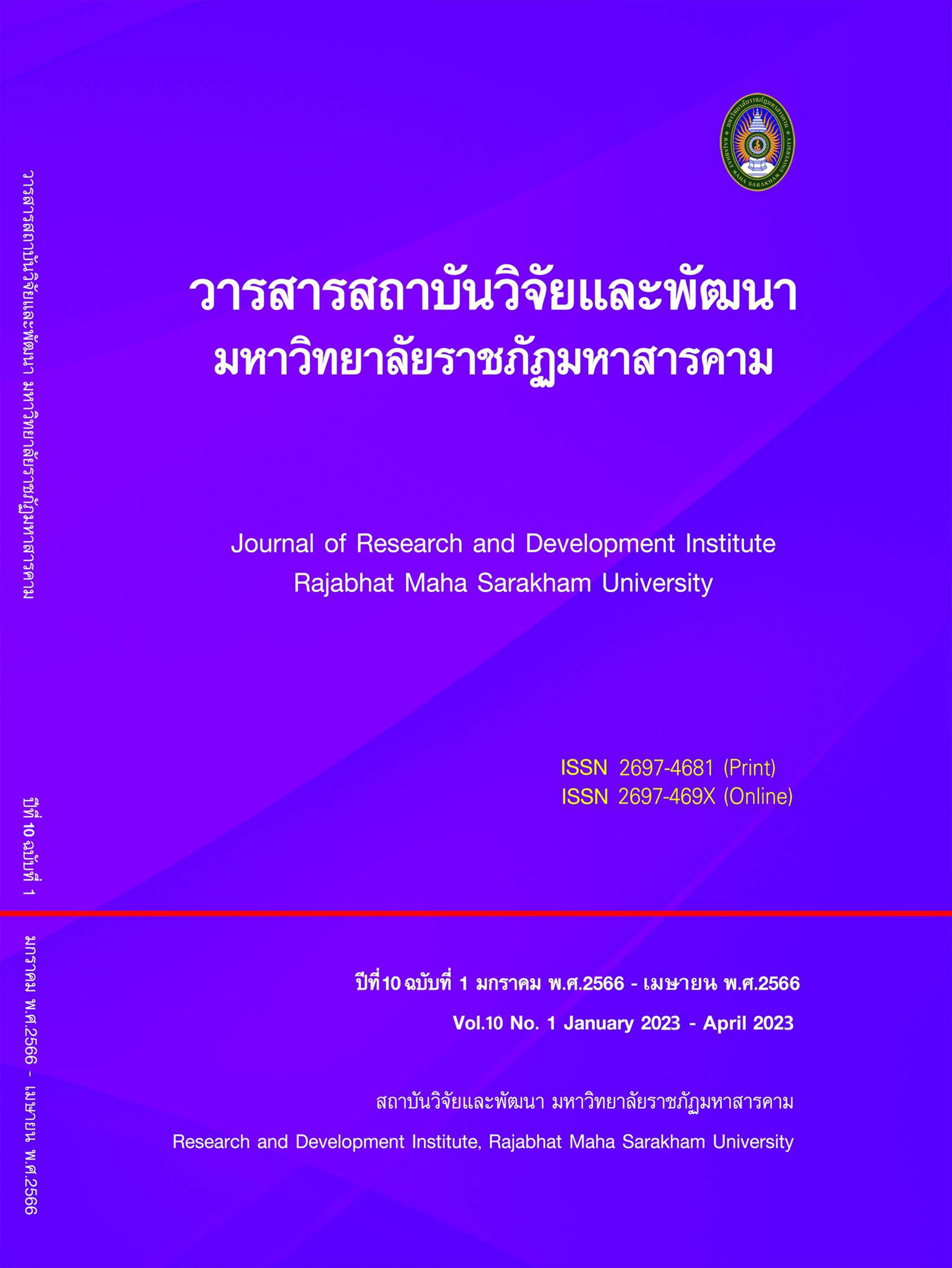A model enhancement of operational efficiency on logistics of entrepreneurs’ frozen pork imported business in Thailand
Keywords:
Enhancement, Operational Efficiency, Entrepreneurs’ Frozen Pork Imported BusinessAbstract
The objectives of this research were: (1) to study the causal factors influencing the operational efficiency on logistics for the satisfaction of entrepreneurs’ frozen pork imported business in Thailand. And (2) to develop a model enhancement operational efficiency on logistics that affect the satisfaction of entrepreneurs’ frozen pork imported business in Thailand. This research is mixed methods research. The quantitative research used a stratified sampling method from a population of 17,380 people by determining the sample size according to the criteria of hair et al. The sample includes 380 entrepreneurs’ frozen pork imported business. And qualitative research used a specific sampling method of 15 participants including entrepreneurs and experts. The tool used to collect data is a questionnaire. The statistics used in this research were percentage, mean, standard deviation and structural equation model analysis by LISREL program.
Major findings: (1) logistics management, information technology, marketing, operational efficiency on logistics and satisfaction of entrepreneurs consistent with empirical data, six indexes that passed the acceptance criteria were index c2/df = 1.203 CGI=1.00, GFI=0.97, AGFI=0.95, RMSEA = 0.021 and SRMR = 0.042. Therefore, it can be concluded that the structural equation model is appropriate and harmonious with the empirical data. and (2) a model enhancement operational efficiency on logistics of entrepreneurs’ frozen pork imported business in Thailand are as follows: logistics management, information technology, marketing, operational efficiency on logistics influences on the satisfaction of entrepreneurs. Therefore, entrepreneurs can use the research model as a guideline for sustainable business operations.
References
Abdullah, N, & S, Yaakub. (2014). Reverse Logistics: Pressure for Adoption and The Impact on Firm's Performance. International Journal of Business and Society. 15(1), 151-170.
Aitken, J., & Harrison, A. (2012). Supply governance structures for reverse logistics systems. International Journal of Operations & Production Management. 33(6). pp. 745-764.
Alarm, A., Bagchi, P, K, Kim, B., Mitra, S., & Seabra, F. (2014). The mediating effect of logistics integration on supply chain performance A multi-country study. The International Journal of Logistics Management. 25(3). 553-580.
Aydın. (2014). Envisioning E-logistics Developments in Turkey on The Way of Accession to The EU: A Focus Group Study. International Journal of Academic Research in Business and Social Sciences. 4(7), ISSN: 2222-6990, Barrera & Mejia.
Boonlar, T., & Nimitphuwadol, N. (2019). Logistics Management: Supply Chain Dimension. Bangkok: SE-EDUCATION.
Boonritthiphon, K. (2010). The strategic logistics service development of a transportation company. Master of Science in Logistics Management: King Mongkut's University of Technology Thonburi.
Charoenmas, A. (2012). Developing the potential of rural roads to enhance logistics management efficiency of road freight forwarders along the Pa Sak River, Nakhon Luang District, Phra Nakhon Si Ayutthaya Province. Phanakhon Si Ayutthaya Rajabhat University.
Cojocariu. (2013). The Reverse Gear of Logistics. Review of International Comparative Management. 14(1).
Datta et al. (2013). Microwave-assisted solubilization of inclusion bodies. Sustainable Chemical Processes. I(2).
Daugherty, Myers & Richey. (2002). Information Support for Reverse Logistics: The Influence of Relationship Commitment. Journal of Business Logistics. 23(1).
Draskovic. (2013). Organization of Outsourcing in Logistics Partnership Between The Seaports of Montenegro and Slovenia. Montenegrin Journal of Economics. 9(1), 93-114.
Gracht, H. and Darkow, I.-L. (2013), "The future role of logistics for global wealth – scenarios and discontinuities until 2025", Foresight, Vol. 15 No. 5, pp. 405-419. https://doi.org/10.1108/FS-05-2012-0031
Hair et al. (1998). Multivariate Data Analysis. 7th ed. Upper Saddle River, NJ: Prentice-Hall.
Hazen & Bryd. (2012). Toward creating competitive advantage with logistics information technology. International Journal of Physical Distribution & Logistics Management. 42(1), 8-35. Emerald Group Publishing Limited.
Huscroft et al. (2012). Reverse logistics information system success and the effect of motivation. International Journal of Physical Distribution & Logistics Management. 44(3), 201-220. Emerald Group Publishing Limited.
Jensen, J, K., K, B, Munksgaard, and J, S, Arlbjørn. (2013). Chasing value offerings through green supply chain innovation. European Business Review. 25(2), 124-146.
Kanjanawasee, S. (2002). Assessment theory. Bangkok: Chulalongkorn University Press
Nagy, G., Wassan, N., & Salhi, S. (2012). The vehicle routing problem with restricted mixing of Deliveries and pickups. New York: Springer.
National Statistical Office (2021). NSO Infographic Booklet 2021. Bangkok: National Statistical Office.
National Statistical Office, (2020). Survey of household socio-economic conditions 2019. Bangkok: National Statistical Office.
Office of Business Development, Department of Business Development. (2021). National strategy in logistics and national security. First Edition, Bangkok: Center for Strategic Studies, National Defense Academy.
Office of the National Economic and Social Development Board. (2016). Driving the National Economic Development Plan. Bangkok : Srinakharinwirot University.
Panagiotidou, Nenes & Zikopoulos. (2013). Optimal procurement and sampling decisions under stochastic yield of returns in reverse supply chains. OR Spectrum. 35, 1-32.
Rogers & Tibben-Lembke. (1998). Going Backwards: Reverse Logistics Trends and Practices.The University of Nevada, Reno Center for Logistics Management.
Rutner, S.M., Aviles, M. & Cox, S., (2012). Logistics evolution: a comparison of military and commercial logistics thought. The International Journal of Logistics Management. 23(1), 96-118.
SCB Economic Intelligence Center. (2014). Keep Watching on Competitive Situation of Grocery Store [Online]. Retrieved January 15, 2016, from http://www. scbeic.com/th/detail/product/289.
Stock, J. R., & Lambert, D. (1997). Fundamentals of Logistics Management. New York: McGraw-Hill/Irwin.
Stock, J. R., & Lambert, D. (1998). Fundamentals of Logistics. New York: McGraw-Hill/Irwin.
Wanitbancha, K. (2014). Using SPSS for Windows to analyze data. Bangkok: Faculty of Commerce and Accountancy, Chulalongkorn University.
Zaarour et al. (2014). A Reverse Logistics Network Model for Handling Returned Products. International Journal of Engineering Business Management. 6(13), 1-10.
Zhang, Zhang & Liu. (2013). Energy-based evaluation of system sustainability and ecosystem value of a large-scale constructed wetland in North China. Environ Monit Assess. 185, 5595-5609.
Downloads
Published
How to Cite
Issue
Section
License
Copyright (c) 2023 สุดารัตน์ มณีโชติ, บุรพร กำบุญ, ศิริพร สัจจานันท์, ฐนันวริน โฆษิตคณิน

This work is licensed under a Creative Commons Attribution-NonCommercial-NoDerivatives 4.0 International License.
Articles that are published are copyrighted by the authors of the articles







